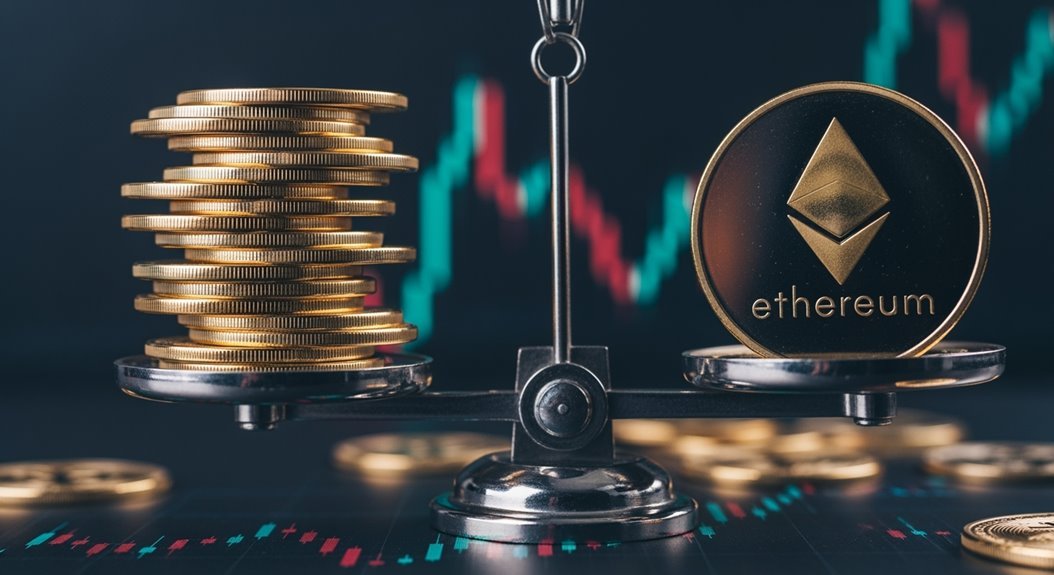Crypto leverage trading lets traders control larger positions by borrowing against their initial capital. A trader with $1,000 can control $10,000 worth of cryptocurrency using 10x leverage. This amplifies both profits and losses dramatically. A 5% price move becomes a 50% gain or loss on the trader’s account. Higher leverage means greater risk of liquidation if the market moves against the position. Beginners typically start with conservative ratios like 10:1 or 20:1. Smart risk management strategies can help navigate these amplified market dynamics.
Fundamentals of Crypto Leverage Trading

While traditional trading requires the full purchase price of an asset, leverage trading in cryptocurrency allows traders to control considerably larger positions by borrowing funds against their initial capital deposit. The mechanism is straightforward. Traders provide collateral—called margin—which secures the borrowed capital and acts as a buffer against losses.
Leverage ratios determine position size. A 10x ratio means controlling $10,000 with just $1,000 of personal capital. Simple math. Greater multiplication equals greater risk. Position size remains constant regardless of leverage used, meaning higher leverage requires less capital to open the same position but increases liquidation risk.
The system supports both directions. Long trades involve buying low and selling high. Short trades mean selling borrowed assets first, then buying them back cheaper later. Both strategies can profit from market movements.
However, markets moving against leveraged positions trigger margin calls. If collateral falls below required levels, liquidation occurs automatically. Risk management isn’t optional—it’s survival. The amplification works both ways: bigger potential profits, bigger potential losses. Trading platforms implement security solutions to protect against automated attacks and maintain system integrity. Successful leverage trading requires active monitoring to prevent overleveraging and protect capital.
How Leverage Amplifies Your Trading Positions and Outcomes
Leverage functions as a financial multiplier that transforms modest capital into substantial market positions. A trader with $1,000 can control $10,000 worth of cryptocurrency using 10x leverage. The math is straightforward.
This amplification cuts both ways. A 5% price increase becomes a 50% gain on the initial margin. But a 5% decline? That’s a 50% loss. High leverage ratios like 50x or 100x make these swings even more dramatic. A mere 1-2% market movement can double profits or wipe out accounts entirely.
The multiplier effect scales linearly. Double the leverage, double the impact. Triple it, triple the consequences. Small market fluctuations suddenly carry enormous weight.
Leverage doesn’t just increase risk—it multiplies it. Every percentage point of market movement becomes a sledgehammer to your portfolio.
Margin requirements decrease as leverage increases. 10x leverage means just 10% collateral needed. This capital efficiency allows traders to diversify across multiple positions. But it also heightens volatility sensitivity. Crypto markets are already turbulent. Leverage amplifies that chaos exponentially. Borrowed funds from exchanges incur interest costs that accumulate over time and can significantly impact overall trading profitability. Platforms implement stop-loss orders to automatically close positions when predetermined price levels are reached, helping traders limit potential losses.
Key Risks and Potential Pitfalls Every Trader Should Know
Three essential dangers lurk beneath leverage trading’s profit potential.
First: liquidation risk. High leverage like 125x means a mere 0.8% price movement against your position wipes out your entire margin. Bitcoin’s recent drop from $68,500 to $66,200 eliminated $180 million in long positions within hours. The exchange forcibly closes your position to prevent further losses. Your capital? Gone.
Second: market volatility amplifies everything. Crypto markets swing wildly. Unpredictable events—regulatory announcements, economic shifts—trigger sudden price movements. Even experienced traders get caught off guard.
Third: psychological warfare begins. Over-leveraging leads to emotional decisions. Chasing losses. Impulsive entries. Stress impairs judgment. Traders abandon their strategies under pressure.
Additional costs compound problems. Trading fees, spreads, and margin interest erode capital faster at high leverage. Poor cost management accelerates depletion during volatile periods. Trading volume surges of 35% during market panic intensify fee accumulation across major platforms.
Platform risks add another layer. Technical failures and outages can prevent essential trade adjustments when markets move against you. Exchange policies may shift unexpectedly, with leverage limits tightening during market stress periods. Traders must provide initial margin as collateral before starting any leveraged position.
Essential Strategies and Best Practices for Getting Started

How does a trader navigate leverage without falling into the traps that destroy accounts? Start conservative. Beginners should stick to 1:10 or 1:20 leverage ratios. Period.
Experienced traders can push higher—1:50 or more—but only with bulletproof risk management. The market doesn’t care about your experience when volatility spikes.
Technical analysis becomes critical. Support and resistance levels, RSI, MACD, Bollinger Bands—these aren’t suggestions. They’re survival tools. Set stop-losses at 1-2% of capital per trade. No exceptions.
Position management matters more than perfect entries. Choose isolated margin for controlled risk or cross margin for flexibility. Monitor margin levels constantly. Liquidation doesn’t send warning shots.
Popular strategies include scalping for quick profits, swing trading for medium trends, and range trading within price bands. Each requires different leverage approaches. Breakout trading demands real-time analysis to spot emerging price movements before major trends develop.
Demo accounts aren’t optional—they’re training grounds. Practice margin management without bleeding real money. Study market behavior religiously. Closing leveraged positions creates taxable events that require proper reporting. The crypto market evolves fast.
Frequently Asked Questions
Which Crypto Exchanges Offer the Highest Leverage Ratios for Trading?
Huobi Futures dominates with extreme leverage up to 1000x on futures and options. MEXC and PrimeXBT offer 200x leverage, with PrimeXBT covering multiple asset classes beyond crypto. BloFin provides 150x on select contracts. Mainstream exchanges cap lower: Binance at 125x, Bitget at 125x, while Bybit and OKX max out at 100x. Lesser-regulated platforms typically offer higher ratios than established exchanges.
What Are the Tax Implications of Profits and Losses From Leverage Trading?
Leverage trading profits trigger capital gains taxes based on crypto’s fair market value at transaction time. Short-term gains face ordinary income rates up to 37%. Long-term holdings get preferential rates. Losses offset gains and up to $3,000 ordinary income annually. Margin interest may be deductible. Every leveraged trade requires reporting on Form 8949. Detailed records of dates, amounts, and fees are essential for compliance.
Can I Use Leverage Trading With All Cryptocurrencies or Only Specific Ones?
Leverage trading isn’t available for all cryptocurrencies. Major coins like Bitcoin and Ethereum dominate these markets due to high liquidity and trading volume. Most exchanges restrict leverage to prominent cryptocurrencies with established markets. Smaller altcoins typically offer limited or no leverage options because of increased risk and low liquidity. Platform policies, regulatory restrictions, and market capitalization ultimately determine which tokens support leveraged trading positions.
How Do Funding Rates Affect the Cost of Holding Leveraged Positions Overnight?
Funding rates directly impact leveraged position costs every eight hours. Positive rates mean long holders pay shorts, increasing overnight expenses. Negative rates generate income for longs. Higher leverage amplifies these effects markedly. A trader with 10x leverage pays or receives ten times the base funding amount. During volatile periods, rates spike unpredictably. Smart traders monitor funding trends closely. Cumulative payments over multiple intervals can erode profits substantially.
What Happens to My Leveraged Position During Extreme Market Volatility or Crashes?
During extreme volatility, leveraged positions face automatic liquidation when collateral drops below maintenance thresholds. Platforms force-sell positions to cover losses, adding price pressure that can worsen crashes. Fragmented crypto liquidity across exchanges creates severe slippage during rapid moves. Traders often can’t react fast enough to manually close positions before getting wiped out. Liquidation cascades intensify market crashes as forced selling triggers more liquidations.



